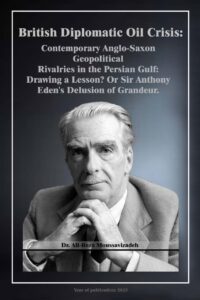The British Imperial Establishment, Post Imperial Era, and the ‘Churchillian’ World View, 1945-2016. (Adjustments & Challenges in Contemporary British Diplomatic Strategy)
12
of social life,
and as the starting point for a definition of the ‘governing elite’ “4,
or as we shall call it ‘political elite’. This is his second way of
describing The
concept which is related to our studies and is his real subject matter. In that
Pareto
goes on by saying: “For the particular investigation with which we are engaged,
a study of
the social equilibrium, it will help if we further divide that class [the
elite] into two classes: a
governing elite comprising individuals who directly or
indirectly play some considerable part in government,
and a non-governing elite
comprising the rest… So we get two strata in a population: (1) A lower
stratum,
the non-elite, with whose possible influence on government we are not here
concerned; then (2)
a higher stratum, the elite, which is divided into two: (a) a
governing elite; (b) a non-governing
elite.”5 Pareto’s earlier writings, such as
‘Cours D’
Economic Politique’ ( in which he propounded the idea of a normal
curve of the distribution of wealth in
a society) and ‘Les Systemes Socialistes’,
explains how he arrived at this conception. In the latter,
he made the following
points: firstly, if individuals were arranged according to other criteria, such
as
their level of intelligence, aptitude for mathematics, musical talent, moral
character, etc. , there
would probably result distribution curves similar to that for
wealth; secondly, if everyone were arranged in
relation to the degree of political
and social power or influence that they hold, it would be found in most
societies
that the same people occupied the same place in this hierarchy as in the hierarchy
of wealth.
From Pareto’s writings one can conclude that he is basically concerned
with the opposition between those
who have power, the ‘governing or political
elite’ and those who have none, the masses, and not the
curve of distribution of
certain attributes (including power and influence). The change in
Pareto’s
conception can be seen as a result of Gaetano Mosca’s work. Mosca was the first
to make
a systematic distinction between elite and masses. His fundamental idea
was expressed in these words:
“Among the constant facts and tendencies that are
to be found in all political organisms, one is so
obvious that it is apparent to the
most casual eye. In all societies – from societies that are very meagerly
developed
Pages: 1 2 3 4 5 6 7 8 9 10 11 12 13 14 15 16 17 18 19 20 21 22 23 24 25 26 27 28 29 30 31 32 33 34 35 36 37 38 39 40 41 42 43 44 45 46 47 48 49 50 51 52 53 54 55 56 57 58 59 60 61 62 63 64 65 66 67 68 69 70 71 72 73 74 75 76 77 78 79 80 81 82 83 84 85 86 87 88 89 90 91 92 93 94 95 96 97 98 99 100 101 102 103 104 105 106 107 108 109 110 111 112 113 114 115 116 117 118 119 120 121 122 123 124 125 126 127 128 129 130 131 132 133 134 135 136 137 138 139 140 141 142 143 144 145 146 147 148 149 150 151 152 153 154 155 156 157 158 159 160 161 162 163 164 165 166 167 168 169 170 171 172 173 174 175 176 177 178 179 180 181 182 183 184 185 186 187 188 189 190 191 192 193 194 195 196 197 198 199 200 201 202 203 204 205 206 207 208 209 210 211 212 213

